THE MALL
 Commonwealth Avenue Mall is a grand allée of shade trees, connecting the Public Garden to the Back Bay Fens and forming the central axis of the Back Bay. Inspired by Parisian boulevards and designed by Arthur Gilman, the Mall was created between 1858 and the 1870s under the Back Bay Development Plan. From its inception, the Mall has been a vital amenity for both residents and visitors. Winston Churchill once praised it as “the grandest boulevard in North America.”
Commonwealth Avenue Mall is a grand allée of shade trees, connecting the Public Garden to the Back Bay Fens and forming the central axis of the Back Bay. Inspired by Parisian boulevards and designed by Arthur Gilman, the Mall was created between 1858 and the 1870s under the Back Bay Development Plan. From its inception, the Mall has been a vital amenity for both residents and visitors. Winston Churchill once praised it as “the grandest boulevard in North America.”
Originally planted with American and European elm trees, the Mall today is a mixture of hardy, large-scale shade trees. While statues were not part of Gilman’s original plan for the long uninterrupted allée of trees, they have become a focal point. Today, the trees, statues, benches, and walkways are important elements of this historic park.
 Launched as part of our 50th Anniversary Campaign efforts in 2020, the Friends is working to design and install permanent lighting for the statues on each block of the Commonwealth Avenue Mall. To learn more about the Commonwealth Avenue Mall Statue Lighting and Landscape Enhancement Project, click here.
Launched as part of our 50th Anniversary Campaign efforts in 2020, the Friends is working to design and install permanent lighting for the statues on each block of the Commonwealth Avenue Mall. To learn more about the Commonwealth Avenue Mall Statue Lighting and Landscape Enhancement Project, click here.
HISTORY
Commonwealth Avenue and its Mall were part of the bold plan to fill Boston’s Back Bay, one of the greatest examples of urban planning in America. Beginning in 1857 and continuing for nearly forty years, new land was made from gravel brought by train from Needham. At the height of the Back Bay’s creation, trains arrived every forty-five minutes, and two new house lots were created each day.
The new streets were laid out in a grid pattern according to an 1856 plan by architect Arthur Gilman, who was only in his twenties but well traveled. Inspired by Parisian boulevards and London’s green squares, Gilman designed long, wide straight streets with extended vistas and a strong central axis. The core of his plan was Commonwealth Avenue and its grassy Mall, designed to create a straight-line vista beneath a canopy of four rows of elm trees.
Wide, straight, and paved with crushed stone, this “noble central avenue” was an immediate draw for promenades, carriage races, and parades, as well as a route to the open country. It served as a model for boulevards across America. Linking the parklands of the Public Garden with those of the Fens, the Mall would come to form a precious link to Boston’s “Emerald Necklace.”
The street was the site of the grandest new mansions, setting a tone of elegance for the entire district. The houses had to be set back twenty feet from the property line, giving extra breadth to the two-hundred-foot-wide boulevard with its two roadways and central Mall. The variety of building styles was unified by the trees on the Mall; the architecture and planting reinforce each other in a unique and powerful way. The green corridor of the Mall enhances and complements some of the country’s finest examples of nineteenth-century residential architecture.
Contrary to popular belief, Frederick Law Olmsted had nothing to do with the Mall’s original design. In 1880, however, he and Charles Sprague Sargent, his partner in creating the Arnold Arboretum, were asked for their advice on the tree planting patterns. They proposed removing the existing four rows of American and European elms and replacing them with two single rows of European elms. The City Council rejected the proposal, however, fearing a public outcry.
Olmsted did design Commonwealth Avenue west of Massachusetts Avenue, making a curving transition between the formal boulevard and the informal park at the western end. The work was completed in 1885, but the area later had to be redesigned.
The street was the site of the grandest new mansions, setting a tone of elegance for the entire district. The houses had to be set back twenty feet from the property line, giving extra breadth to the two-hundred-foot-wide boulevard with its two roadways and central Mall. The variety of building styles was unified by the trees on the Mall; the architecture and planting reinforce each other in a unique and powerful way. The green corridor of the Mall enhances and complements some of the country’s finest examples of nineteenth-century residential architecture.
SCULPTURE AND MEMORIALS
The original design for the Mall did not include public art, but today there are nine sculptures and memorials between Arlington Street and Charlesgate East, adding to the Mall’s distinctive charm and character. All the works are oriented to the east, facing toward the Public Garden, except for Leif Erikson, who gazes westward.
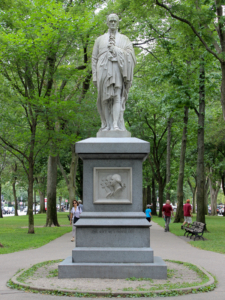 The first statue appeared in 1865 on the newly made land between Arlington and Berkeley Streets. The granite likeness of Alexander Hamilton (1757-1804) was the gift of Thomas Lee, who also donated the Ether Monument in the Public Garden. Sculpted by physician William Rimmer, the work is not highly regarded for its artistic skill. Hamilton was a Revolutionary War soldier, a signer of the Constitution, and the first secretary of the treasury, serving under Washington. He was killed in a famous duel with Aaron Burr in 1804. His likeness can be seen on the ten-dollar bill.
The first statue appeared in 1865 on the newly made land between Arlington and Berkeley Streets. The granite likeness of Alexander Hamilton (1757-1804) was the gift of Thomas Lee, who also donated the Ether Monument in the Public Garden. Sculpted by physician William Rimmer, the work is not highly regarded for its artistic skill. Hamilton was a Revolutionary War soldier, a signer of the Constitution, and the first secretary of the treasury, serving under Washington. He was killed in a famous duel with Aaron Burr in 1804. His likeness can be seen on the ten-dollar bill.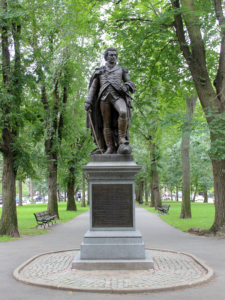 The 1875 bronze and granite sculpture of John Glover (1732-1797) was the work of Martin Milmore, who also designed the Soldiers and Sailors Monument on the Boston Common. General Glover led the Marblehead, Massachusetts, regiment of fishermen who distinguished themselves throughout the Revolutionary War. It was Glover’s regiment that saved Washington and his troops at the Battle of Long Island and, most famously, rowed Washington across the Delaware River through ice and snow.Contrary to popular belief, Frederick Law Olmsted had nothing to do with the Mall’s original design. In 1880, however, he and Charles Sprague Sargent, his partner in creating the Arnold Arboretum, were asked for their advice on the tree planting patterns. They proposed removing the existing four rows of American and European elms and replacing them with two single rows of European elms. The City Council rejected the proposal, however, fearing a public outcry.
The 1875 bronze and granite sculpture of John Glover (1732-1797) was the work of Martin Milmore, who also designed the Soldiers and Sailors Monument on the Boston Common. General Glover led the Marblehead, Massachusetts, regiment of fishermen who distinguished themselves throughout the Revolutionary War. It was Glover’s regiment that saved Washington and his troops at the Battle of Long Island and, most famously, rowed Washington across the Delaware River through ice and snow.Contrary to popular belief, Frederick Law Olmsted had nothing to do with the Mall’s original design. In 1880, however, he and Charles Sprague Sargent, his partner in creating the Arnold Arboretum, were asked for their advice on the tree planting patterns. They proposed removing the existing four rows of American and European elms and replacing them with two single rows of European elms. The City Council rejected the proposal, however, fearing a public outcry.
Olmsted did design Commonwealth Avenue west of Massachusetts Avenue, making a curving transition between the formal boulevard and the informal park at the western end. The work was completed in 1885, but the area later had to be redesigned.
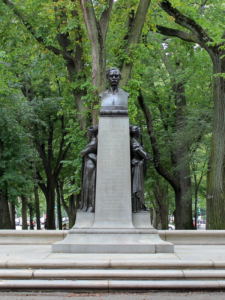 This block features two works of art. The bronze and granite memorial for Patrick Andrew Collins (1844-1905) was created by Henry Kitson and Theo Alice Kitson in 1908 and moved from Charlesgate West, displaced by construction of the Bowker Overpass, to this block of the Mall in 1966. An Irish immigrant, Collins rose to become mayor of Boston, serving from 1902 until his sudden death in 1905. Collins was such a popular mayor that funds were raised for this memorial only six days after his death. His bronze portrait bust rests on a granite base that is flanked by two allegorical figures representing his native land and his adopted country; the one with the lyre is Ireland.
This block features two works of art. The bronze and granite memorial for Patrick Andrew Collins (1844-1905) was created by Henry Kitson and Theo Alice Kitson in 1908 and moved from Charlesgate West, displaced by construction of the Bowker Overpass, to this block of the Mall in 1966. An Irish immigrant, Collins rose to become mayor of Boston, serving from 1902 until his sudden death in 1905. Collins was such a popular mayor that funds were raised for this memorial only six days after his death. His bronze portrait bust rests on a granite base that is flanked by two allegorical figures representing his native land and his adopted country; the one with the lyre is Ireland.
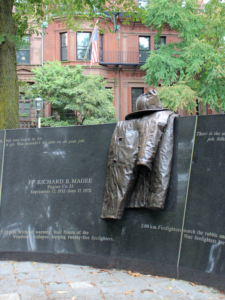 The other memorial in this block, near Dartmouth Street, is the Vendome Firefighters’ Memorial sculpted by Theodore Clausen with Peter White, landscape architect. It honors the nine firefighters who died on June 17, 1972, when four floors of the Hotel Vendome collapsed after a raging fire. Dedicated in 1997, on the twenty-fifth anniversary of the fire, the memorial is an elliptical granite arc with a bronze casting of a helmet and coat resting on it. The former Hotel Vendome is located diagonally across the street.
The other memorial in this block, near Dartmouth Street, is the Vendome Firefighters’ Memorial sculpted by Theodore Clausen with Peter White, landscape architect. It honors the nine firefighters who died on June 17, 1972, when four floors of the Hotel Vendome collapsed after a raging fire. Dedicated in 1997, on the twenty-fifth anniversary of the fire, the memorial is an elliptical granite arc with a bronze casting of a helmet and coat resting on it. The former Hotel Vendome is located diagonally across the street.
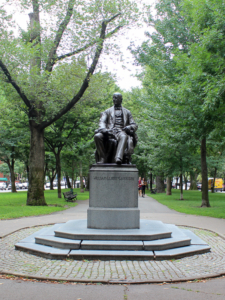 The seated bronze statue of abolitionist William Lloyd Garrison (1805-1879) was sculpted by Olin Levi Warner and dedicated in 1886. Known as “the emancipator,” Garrison came to Boston from Baltimore in 1831 and launched his anti-slavery publication The Liberator, which he continued to publish until the abolition of slavery in 1865. He was also the founder, in 1832, of the New England Anti-Slavery Society. Hounded by angry mobs for his views, he was often in danger for his life. Garrison also supported the movements for women’s rights, temperance, pacifism, and free trade.
The seated bronze statue of abolitionist William Lloyd Garrison (1805-1879) was sculpted by Olin Levi Warner and dedicated in 1886. Known as “the emancipator,” Garrison came to Boston from Baltimore in 1831 and launched his anti-slavery publication The Liberator, which he continued to publish until the abolition of slavery in 1865. He was also the founder, in 1832, of the New England Anti-Slavery Society. Hounded by angry mobs for his views, he was often in danger for his life. Garrison also supported the movements for women’s rights, temperance, pacifism, and free trade.
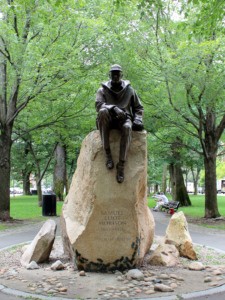 The statue of Bostonian Samuel Eliot Morison (1887-1976) shows the maritime historian and avid sailor casually dressed and seated on a large granite rock. Morison was a Harvard professor and the foremost American maritime historian of the twentieth century. An expert sailor, he retraced one of the voyages of Columbus across the Atlantic using the original log books as a guide. In 1964 Morison was awarded the Presidential Medal of Freedom, the country’s highest civilian honor. His bronze figure was sculpted by well-known Boston artist Penelope Jencks and dedicated in 1982.
The statue of Bostonian Samuel Eliot Morison (1887-1976) shows the maritime historian and avid sailor casually dressed and seated on a large granite rock. Morison was a Harvard professor and the foremost American maritime historian of the twentieth century. An expert sailor, he retraced one of the voyages of Columbus across the Atlantic using the original log books as a guide. In 1964 Morison was awarded the Presidential Medal of Freedom, the country’s highest civilian honor. His bronze figure was sculpted by well-known Boston artist Penelope Jencks and dedicated in 1982.
Dedicated in 2003, the Boston Women’s Memorial is the newest sculpture on the Mall, donated with funds raised by the Boston Women’s Commission. The effort began in 1992 when Mayor Thomas M. Menino reserved the Fairfield to Gloucester block as the site for a memorial honoring women. The commission worked for ten years to select the subjects, choose the artist, raise the money, and oversee construction and installation of the memorial. The bronze figures, by New York artist Meredith Bergmann, are at ground level, not on top of pedestals. The women are shown in casual poses, writing and thinking.
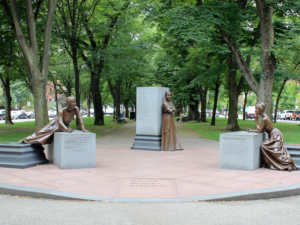
The three women honored share a Boston connection, a place in national history, and a passion for social justice. Abigail Adams (1744-1818) was the wife of the second president of the United States and mother of the sixth, whose letters established her as a strong voice for women’s advancement. Phillis Wheatley (1753-1784), an enslaved child brought from Africa to Boston, became a literary prodigy whose poems were the first book published in America by an African writer. Lucy Stone (1818-1893) was an ardent abolitionist and suffragist, a renowned orator, and a leading figure in the struggle for women’s rights, inspiring Susan B. Anthony and others.
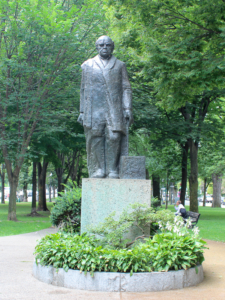 The bronze, stiffly posed statue of Domingo F. Sarmiento (1811-1888) was signed by Yvette Compagnion and dedicated in 1973. Sarmiento, who served as president of Argentina, founded his country’s education system, modeling it on the one developed in Boston by Horace Mann. In appreciation, the Argentine government offered a statue as a gift to the City of Boston in 1913. The statue did not arrive until sixty years later, and finding a spot for it was problematic. The location on the Mall opposite the former International Institute was finally agreed upon.
The bronze, stiffly posed statue of Domingo F. Sarmiento (1811-1888) was signed by Yvette Compagnion and dedicated in 1973. Sarmiento, who served as president of Argentina, founded his country’s education system, modeling it on the one developed in Boston by Horace Mann. In appreciation, the Argentine government offered a statue as a gift to the City of Boston in 1913. The statue did not arrive until sixty years later, and finding a spot for it was problematic. The location on the Mall opposite the former International Institute was finally agreed upon.
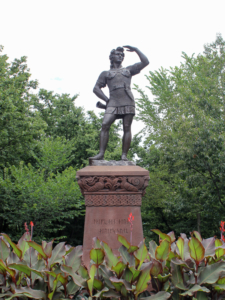 The monument to legendary Norse explorer Leif Erikson (975-1020) commemorates the landing he is believed to have made somewhere along the New England coast, at a site given the name Vinland. Eben Horsford, the patent-medicine maker who donated the memorial in 1887, believed that Vinland was located on the Charles River. The explorer’s life-size bronze figure, sculpted by the eminent American artist Anne Whitney, originally overlooked the river, but that view has been replaced by roadways. The dragon’s head on the prow used to spout water, but the fountain is now dry.
The monument to legendary Norse explorer Leif Erikson (975-1020) commemorates the landing he is believed to have made somewhere along the New England coast, at a site given the name Vinland. Eben Horsford, the patent-medicine maker who donated the memorial in 1887, believed that Vinland was located on the Charles River. The explorer’s life-size bronze figure, sculpted by the eminent American artist Anne Whitney, originally overlooked the river, but that view has been replaced by roadways. The dragon’s head on the prow used to spout water, but the fountain is now dry.

